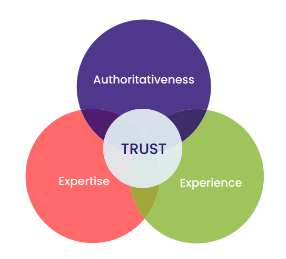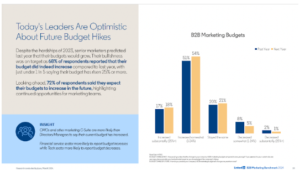Just about everyone knows what SEO is these days, and nearly every professional brand has at least a basic content strategy in place to rank for relevant keywords and attract organic attention. The more crowded the internet becomes with these competing brands, however, the more difficult it has become to stand out.
Gone are the days when keyword stuffing and writing consistent blogs once a week were enough to get your website noticed. If you want to earn high SERP rankings and drive the right audiences to your content in a digital environment where everybody’s churning out content like there’s no tomorrow, you’re going to have to find a way for your content to rise above the rest.
That isn’t necessarily as difficult as it may sound. Leveling up your SEO content strategy won’t require you to devote your entire budget to producing Spielberg-quality videos or going viral on TikTok. Instead, getting your content noticed in a crowded market is mostly about learning how to make what you’re doing right now a little more targeted, contextually relevant, and informed by data.
To demonstrate, here are some examples of the qualities that differentiate a basic, keep-the-lights-on SEO content strategy from a more advanced and sophisticated form capable of driving much more powerful results. If you’d like to learn more about elevating your own strategy, we welcome you to explore our SEO services.
Keyword targeting
Basic: Targeting primary keywords only
In a basic SEO content strategy, the primary focus is on targeting high-volume primary keywords. This approach often involves identifying a few generic keywords related to the business or industry and creating content optimized around those terms.
What makes this strategy ineffective is how it overlooks user intent and fails to capture the diversity of search queries. By targeting only the broadest, highest-level keywords, you have no way to connect your content with users who are searching for something specific.
We share an example of how this approach can fall short in our SEO content guide, Marketing with Intent:
“For a very long time, raw keyword volume ruled SEO. This mindset became ingrained over the years, to the point where a B2B campaign will target a keyword like ‘what is digital transformation’ on the premise that it receives very high search volume and is relevant to their tech solution. Both technically true! Unfortunately, it’s an impossibly competitive term because it’s relevant to every tech solution.”
Advanced: Topical clusters and intent-driven long-tails
An advanced strategic approach for targeting keywords involves more nuance. Instead of solely targeting primary keywords, emphasize building topical clusters to deliver a breadth of focused coverage.
In practice, this might take shape as a hub-and-spoke of sorts, with high-volume topics at the center and longer-tail keywords or variations branching out from it. This intent-driven content can explore different facets of the topic through the lens of your buyer’s journey.
Matching search intent is one of the most significant ways you can capture relevant search traffic.
Content quality
Basic: Shallow coverage and a focus on robots
A basic SEO content strategy emphasizes quantity over quality. Content tends to provide superficial coverage of topics, lacking in-depth research and insights. The primary goal may be to meet a specific word count or number of blog posts per month without necessarily adding substantial value to the reader.
Content is often created with the sole purpose of satisfying what you think the search engine robots are looking for. Maybe a robot even wrote it! This can lead to a disconnect between what you’ve created and what users find valuable.
Not all content is valuable! Crowding your website with low-quality pages threatens to have a negative effect on your overall search authority and visibility.
Advanced: Comprehensive coverage written for humans
In contrast, advanced content strategy prioritizes quality over quantity. Instead of aiming for a specific word count, the content is meticulously researched and comprehensive in its coverage of topics, regardless of total length. This builds on the concept of topical clusters: by writing thoroughly and clearly on each of the subtopics within a cluster, content strategists ensure they’re fully addressing each topic and providing valuable information to their audiences.
Advanced SEO content is also written for people first. In light of Google’s 2022 “Helpful Content” update, you are more likely to rank well if your content is helpful to the person reading it. Ironically, the best way to give search engines the content they want now is to focus less on what they want—and prioritize your actual audience instead.
Strategic alignment
Basic: Content and SEO silos
A basic content strategy will often involve treating SEO and content creation as separate entities with minimal collaboration. The content creation process may be informed more by intuition and whims than by data-backed SEO insights. This is often the result of a lack of coordination between the teams responsible for SEO and content, or a lack of resources dedicated to both.
In other instances, companies may have a lower-performing strategy as a result of viewing SEO input as a one-time task, focusing on on-page optimization and neglecting the broader strategic alignment with other marketing activities.
Advanced: Strategic, holistic integration
An advanced strategy prioritizes integrating the work of the SEO and content teams into a holistic, always-on marketing approach. Data-backed SEO insights inform the content strategy from the outset, ensuring that content is not only optimized for search engines but also aligned with broader business goals and audience needs.
A fully mature SEO content strategy has SEO and content teams collaborate closely, sharing data, insights, and goals. Content creation is guided by a comprehensive understanding of target audiences, keyword research, and overarching marketing strategies. The content serves as a valuable asset in supporting various stages of the customer journey.
Because the internet never stops, neither does a best-in-class SEO content strategy. Analytics and reporting for these two functions should be intertwined, enabling SEO insights to continually shape content planning, optimizations, and decision-making.
Ready to build an advanced SEO content strategy? Discover everything you need to know in our guide, Building an SEO Strategy in 2024.
The post SEO Content Strategy: From Basic to Advanced appeared first on B2B Marketing Blog – TopRank®.
Source: feedburner.com



